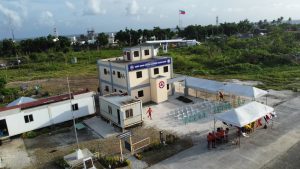The Philippines plans to upgrade the features that it occupies in the South China Sea in order to make them more habitable for troops, the country’s military chief said yesterday, at a time of heightened tension with China over clashing maritime claims.
Speaking to reporters, after attending a command conference led by President Ferdinand Marcos Jr. at the military headquarters, Romeo Brawner said that the country would develop the nine “islands and other features” that it held, Reuters reported.
These include Thitu Island, the most strategically important feature in what Manila terms the Kalayaan Island Group, which lies around 480 kilometers from Palawan island. Another is Second Thomas Shoal, around 225 kilometers closer to Palawan, which has been the subject of a loose Chinese blockade for much of the past year.
“We’d like to improve all the nine, especially the islands we are occupying,” Brawner said. “We are just trying to make it more livable, more habitable for our soldiers because they really have poor living conditions.”
Brawner said that the government hoped to install desalination machines and communications equipment on Thitu Island and Nanshan Island. Thitu, known to Manila as Pag-asa, is the largest Philippine-occupied feature in the South China Sea, boasting an airstrip and landing dock, and supporting a population of around 200. A handful of Philippine soldiers and their families are stationed on Nanshan or Lawak Island. All nine Philippine-occupied outposts exist in a precarious umbilical relationship to the Philippine mainland, reliant on regular navy supply missions and acutely vulnerable to blockade by Chinese vessels.
Most notably, Brawner said that the Armed Forces of the Philippines (AFP) also hopes to deliver a desalination machine for the small group of troops living aboard the MRP Sierra Madre, a warship that the Philippines deliberately grounded on Second Thomas Shoal in 1999 in order to assert its claim over the feature.
The announcement follows – indeed, is a direct result of – a year of intensifying tensions in the South China Sea, where China has ramped up its incursions into Philippine-claimed waters. Much of China’s attention has focused on Second Thomas Shoal, a submerged feature that lies within the Philippines’ exclusive economic zone. Over the past year, Chinese vessels have attempted to impede the Philippine Navy from resupplying the troops aboard the Sierra Madre, resulting in several incidents in which Chinese vessels have collided with Philippine resupply boats.
Installing a desalination machine aboard the Sierra Madre would reduce the necessary frequency of resupply missions, and play some role in sustaining the precarious Philippine toehold on Second Thomas Shoal. However, Brawner clarified that “fortifying the Sierra Madre” was not being considered despite the ship’s decrepit state and fears that it might soon crumble into the ocean.
China’s government considers any construction work on Second Thomas Shoal to be something of a red line, claiming that the grounding of the ship was illegal and asserting that past Philippine leaders have promised to remove it.
In August, following a number of confrontations at Second Thomas Shoal, a spokesperson for the Chinese Embassy in Manila issued a statement alleging that the Philippines had “tried to deliver the construction materials for overhauling and reinforcing the ‘grounded’ military vessel.” It added, “Under such circumstances, the Chinese side was made to respond with necessary moves.”
In addition to reinforcing the personnel stationed on the Philippines’ remote ocean outposts, Brawner said that the AFP also plans on acquiring more ships, radars, and aircraft in order more effectively to patrol the contested waters.
The Philippine plans are a fairly predictable outcome of China’s recent assertiveness. Far from backing down, Manila has greatly strengthened its relations with the United States in search of a deterrent and taken steps to bolster its hold over the nine islands and features under its control, in the confidence that it has the weight of international law firmly on its side.
None of this solves the question of how the Philippines would hold onto these features should China choose to intensify its pressure campaign. But for the time being it demonstrates Manila’s determination to meet Beijing’s escalating “gray zone” tactics, which aim to coerce while falling short of overt acts of war, with adjustments of its own.

































